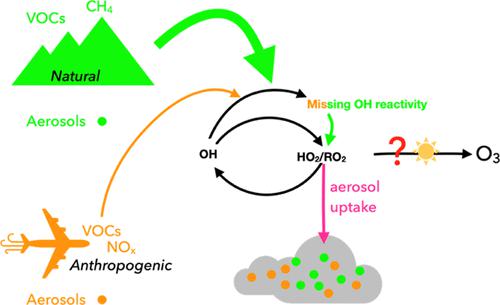当前位置:
X-MOL 学术
›
Environ. Sci. Technol.
›
论文详情
Our official English website, www.x-mol.net, welcomes your feedback! (Note: you will need to create a separate account there.)
Potential Factors Contributing to Ozone Production in AQUAS–Kyoto Campaign in Summer 2020: Natural Source-Related Missing OH Reactivity and Heterogeneous HO2/RO2 Loss
Environmental Science & Technology ( IF 11.4 ) Pub Date : 2022-09-07 , DOI: 10.1021/acs.est.2c03628 Jiaru Li 1, 2 , Nanase Kohno 1 , Yosuke Sakamoto 1, 2, 3 , Huy Gia Pham 1 , Kentaro Murano 1 , Kei Sato 2 , Tomoki Nakayama 4 , Yoshizumi Kajii 1, 2, 3
Environmental Science & Technology ( IF 11.4 ) Pub Date : 2022-09-07 , DOI: 10.1021/acs.est.2c03628 Jiaru Li 1, 2 , Nanase Kohno 1 , Yosuke Sakamoto 1, 2, 3 , Huy Gia Pham 1 , Kentaro Murano 1 , Kei Sato 2 , Tomoki Nakayama 4 , Yoshizumi Kajii 1, 2, 3
Affiliation

|
This study presents total OH reactivity, ancillary trace species, HO2 reactivity, and complex isoprene-derived RO2 reactivity due to ambient aerosols measured during the air quality study (AQUAS)–Kyoto campaign in September, 2020. Observations were conducted during the coronavirus disease (COVID-19) pandemic (associated with reduced anthropogenic emissions). The spatial distribution of missing OH reactivity highlights that the origin of volatile organic compounds (VOCs) may be from natural-emission areas. For the first time, the real-time loss rates of HO2 and RO2 onto ambient aerosols were measured continuously and alternately. Ozone production sensitivity was investigated considering unknown trace species and heterogeneous loss effects of XO2 (≡HO2 + RO2) radicals. Missing OH reactivity enhanced the ozone production potential by a factor of 2.5 on average. Heterogeneous loss of radicals could markedly suppress ozone production under low NO/NOx conditions with slow gas-phase reactions of radicals and change the ozone regime from VOC- to NOx-sensitive conditions. This study quantifies the relationship of missing OH reactivity and aerosol uptake of radicals with ozone production in Kyoto, a low-emission suburban area. The result has implications for future NOx-reduction policies. Further studies may benefit from the combination of chemical transport models and inverse modeling over a wide spatiotemporal range.
中文翻译:

2020 年夏季 AQUAS-Kyoto 活动中促成臭氧生成的潜在因素:与天然源相关的 OH 反应性缺失和异质 HO2/RO2 损失
本研究介绍了2020 年 9 月的空气质量研究 (AQUAS)-京都活动期间测量的环境气溶胶引起的总 OH 反应性、辅助痕量物质、HO 2反应性和复杂异戊二烯衍生的 RO 2反应性。在冠状病毒期间进行了观察疾病 (COVID-19) 大流行(与人为排放减少相关)。缺少 OH 反应性的空间分布突出表明挥发性有机化合物 (VOC) 的来源可能来自自然排放区域。HO 2和 RO 2的实时丢失率对环境气溶胶的影响是连续交替测量的。考虑到未知的痕量物种和 XO 2 (≡HO 2 + RO 2 ) 自由基的异质损失效应,研究了臭氧产生的敏感性。缺少 OH 反应性使臭氧生产潜力平均提高了 2.5 倍。自由基的非均相损失可以显着抑制低 NO/NO x条件下的臭氧产生,自由基的气相反应缓慢,并将臭氧状态从 VOC 敏感条件变为 NO x敏感条件。本研究量化了低排放郊区京都缺少 OH 反应性和气溶胶吸收自由基与臭氧产生之间的关系。该结果对未来的 NO 有影响x - 减少政策。进一步的研究可能会受益于在广泛的时空范围内结合化学传输模型和逆向建模。
更新日期:2022-09-07
中文翻译:

2020 年夏季 AQUAS-Kyoto 活动中促成臭氧生成的潜在因素:与天然源相关的 OH 反应性缺失和异质 HO2/RO2 损失
本研究介绍了2020 年 9 月的空气质量研究 (AQUAS)-京都活动期间测量的环境气溶胶引起的总 OH 反应性、辅助痕量物质、HO 2反应性和复杂异戊二烯衍生的 RO 2反应性。在冠状病毒期间进行了观察疾病 (COVID-19) 大流行(与人为排放减少相关)。缺少 OH 反应性的空间分布突出表明挥发性有机化合物 (VOC) 的来源可能来自自然排放区域。HO 2和 RO 2的实时丢失率对环境气溶胶的影响是连续交替测量的。考虑到未知的痕量物种和 XO 2 (≡HO 2 + RO 2 ) 自由基的异质损失效应,研究了臭氧产生的敏感性。缺少 OH 反应性使臭氧生产潜力平均提高了 2.5 倍。自由基的非均相损失可以显着抑制低 NO/NO x条件下的臭氧产生,自由基的气相反应缓慢,并将臭氧状态从 VOC 敏感条件变为 NO x敏感条件。本研究量化了低排放郊区京都缺少 OH 反应性和气溶胶吸收自由基与臭氧产生之间的关系。该结果对未来的 NO 有影响x - 减少政策。进一步的研究可能会受益于在广泛的时空范围内结合化学传输模型和逆向建模。


























 京公网安备 11010802027423号
京公网安备 11010802027423号